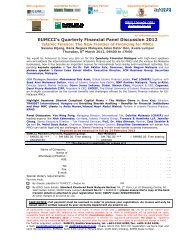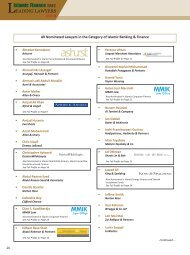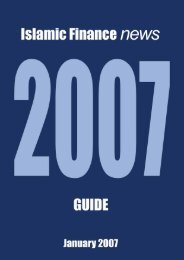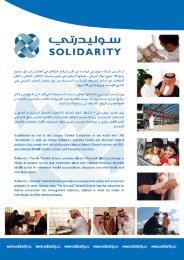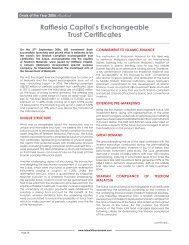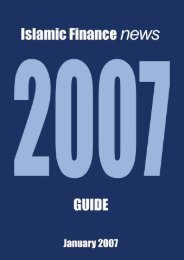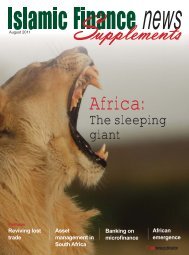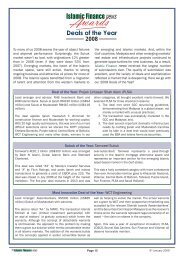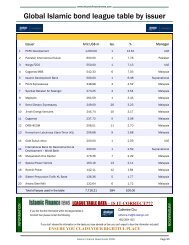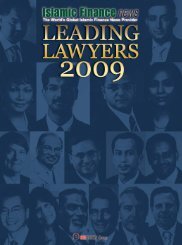View PDF Edition - Islamic Finance News
View PDF Edition - Islamic Finance News
View PDF Edition - Islamic Finance News
You also want an ePaper? Increase the reach of your titles
YUMPU automatically turns print PDFs into web optimized ePapers that Google loves.
deals of the year<br />
case study<br />
GACA’s US$4 billion guaranteed<br />
senior Sukuk<br />
Deal of the Year & Saudi Arabia Deal of the Year<br />
The Saudi General Authority of Civil Aviation (GACA)<br />
successfully closed its SAR15 billion (US$4 billion) Sukuk<br />
offering on the 15 th January. The Sukuk was three times<br />
oversubscribed and was priced at the tighter end of<br />
guidance at a yield of 2.5%. The issuance is guaranteed by<br />
the ministry of finance and has been approved by Saudi<br />
Arabian Monetary Agency (SAMA). The proceeds of the<br />
SAR15 billion GACA Sukuk will be used to part-finance the<br />
construction of the SAR27.1 billion (US$7.23 billion) King<br />
Abdul Aziz International Airport in Jeddah.<br />
This was the first major Saudi quasi-sovereign to raise funds<br />
from the Saudi riyal market through a Sukuk issuance. Hitherto<br />
it has been utilities that have led the way in Sukuk origination<br />
in the kingdom. Walid Khoury, CEO of HSBC Saudi Arabia,<br />
highlighted that the issuance was the largest single-tranche<br />
Sukuk ever issued.<br />
Given the scarcity of Saudi government debt issuance,<br />
particularly Sukuk, the sizable issuance will offer a profitability<br />
boost to local <strong>Islamic</strong> finance institutions, which make up 20%<br />
of the system by assets.<br />
The Sukuk’s benchmark status will allow it to be repo-ed or<br />
quickly sold for cash, which will go a long way to improving<br />
their liquidity positions. However, this may be undermined by<br />
the under-developed secondary trading market that currently<br />
exists on the Tadawul platform.<br />
Fahad Al-Saif, a director and the head of debt capital markets<br />
at HSBC Saudi Arabia, said that the GACA Sukuk issuance had<br />
conceptually set the new risk-free rate for the Saudi Arabian<br />
markets.<br />
The GACA issuance presents Saudi banks with a muchneeded<br />
benchmark with which to price longer-tenured local<br />
currency issuances, helping to build a much needed local<br />
yield curve. This is important as Saudi banks, along with other<br />
GCC banks, possess severe asset/liability mismatches on their<br />
balance sheets given the dearth of long-term market funding<br />
opportunities.<br />
As of the end of September 2011, 91% of the banks’ non-equity<br />
funding was funded with short-term deposits and as such, a<br />
deeper bond market would support more longer-term funding<br />
for Saudi banks and ultimately encourage the reduction of<br />
these persistent asset/liability mismatches.<br />
In the context of sustained fiscal surpluses, the Saudi<br />
government has been aggressively reducing the amount of<br />
government debt outstanding over the past decade. Strong<br />
Issuer<br />
Issuance size<br />
Purpose of issuance<br />
Guarantor<br />
Tenor<br />
Coupon rate / return<br />
Rating<br />
Currency<br />
Summary of terms & conditions<br />
economic growth and high oil revenues, along with relatively<br />
limited domestic investment opportunities, are creating an<br />
excess of liquidity in the local banking system.<br />
At SAR15 billion, the Sukuk’s size is approximately 12% of the<br />
total cash and cash equivalents of the Saudi banking system<br />
and 38% of cash and cash equivalents of <strong>Islamic</strong> financial<br />
institutions in Saudi Arabia. The GACA Sukuk will therefore go<br />
a long way towards absorbing some of this excess, helping to<br />
moderate some of its inflationary credit growth.<br />
The quasi-sovereign nature of the Sukuk has led many to<br />
speculate if these will serve as a prelude to the first Saudi<br />
sovereign Sukuk. However, the kingdom officially does not<br />
need to raise funding from the debt market as the total 2012<br />
budget is currently met by existing oil revenue. In addition, on<br />
the regulatory and legal front, the architecture that handles<br />
<strong>Islamic</strong> finance must undergo significant revision before such<br />
consulting www.<strong>Islamic</strong><strong>Finance</strong>Consulting.com<br />
www.<strong>Islamic</strong><strong>Finance</strong>Events.com<br />
a push would be considered.<br />
www.<strong>Islamic</strong><strong>Finance</strong><strong>News</strong>.com<br />
General Authority of Civil Aviation (GACA)<br />
SAR15 billion (US$4 billion)<br />
The funds from the Sukuk issuance will be<br />
used for the construction of the new King<br />
Abdul Aziz International Airport in Jeddah<br />
Ministry of <strong>Finance</strong><br />
10 years<br />
2.5% yield<br />
‘Aa3’ — Moody’s<br />
Saudi riyal<br />
Maturity date 18 th January 2022<br />
Joint lead manager<br />
and bookrunner<br />
Structure /<br />
instrument<br />
Investor breakdown<br />
HSBC Middle East<br />
Murabahah<br />
The offering, sale and delivery of the<br />
Sukuk was limited solely to Saudi<br />
nationals and sophisticated investors<br />
and those other legal persons with a<br />
permanent establishment in the kingdom,<br />
registered with the ministry of commerce<br />
and industry.<br />
www.MIFtraining.com<br />
www.REDmoneyBooks.com<br />
4 March 2013<br />
www.<strong>Islamic</strong><strong>Finance</strong>Training.com<br />
www.MIFforum.com<br />
www.MIFmonthly.com



